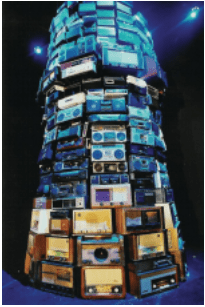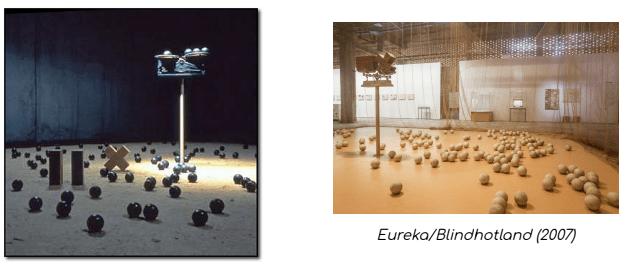Cildo Meireles
Victoria Haaker
I was first drawn to Cildo Merieles because of his work Babel. Modern takes on religious subjects have always gained my attention, mainly due to my complex relationship with religion and the Church I have been in my entire life. The digital artwork is based on the story around The Tower of Babel, in which humans try to build a tower tall enough to reach the heavens. God, who is offended by this, cursed the builders to begin to all speak different languages so that they could not complete it.
 Babel takes a modern twist on the story with a tall sculptural installation built from hundreds of radios. The height ranges from location to location but is around eight meters tall. The radios are sourced second hand and range in age and style. Each radio is set to a low volume and various stations in various languages. These competing voices create a cacophony of indiscernible sounds, equalling an almost white noise. This piece references the overwhelming amount of media and voices we hear around us constantly, and the impact it can have. While the growing quickness and accessibility of technology has its advantages, it also means we hear hundreds of opinions, stories, and facts in a single day. Babel illustrates the harm in this, showing that we can truly only listen and learn from one voice, too many creates a canceling effect. It is a paradox that we have so much information at our hands, and yet we rarely comprehend any of it. Meireles often comments on modern democracy and the metaphor in Babel is no different. The basis of democracy is that everyone has a voice, and yet this means that few actually understand what is important or have power in their choices. If middle aged women on Facebook can have the same outreach as our elected officials, is anything actually going to get done? It is important to consider the message behind Babel when faced with the easy ideals and evolution of our modern world.
Babel takes a modern twist on the story with a tall sculptural installation built from hundreds of radios. The height ranges from location to location but is around eight meters tall. The radios are sourced second hand and range in age and style. Each radio is set to a low volume and various stations in various languages. These competing voices create a cacophony of indiscernible sounds, equalling an almost white noise. This piece references the overwhelming amount of media and voices we hear around us constantly, and the impact it can have. While the growing quickness and accessibility of technology has its advantages, it also means we hear hundreds of opinions, stories, and facts in a single day. Babel illustrates the harm in this, showing that we can truly only listen and learn from one voice, too many creates a canceling effect. It is a paradox that we have so much information at our hands, and yet we rarely comprehend any of it. Meireles often comments on modern democracy and the metaphor in Babel is no different. The basis of democracy is that everyone has a voice, and yet this means that few actually understand what is important or have power in their choices. If middle aged women on Facebook can have the same outreach as our elected officials, is anything actually going to get done? It is important to consider the message behind Babel when faced with the easy ideals and evolution of our modern world.
See photo 1: https://www.alamy.com/cildo-meireles-babel-2001-at-the-tate-modern-london-uk-image238918385.html
Another of Meireles’ most interesting works is Eureka/Blindhotland. This is an interactive installation composed of many diverse pieces. The installation takes place in a darkened room in which a spotlight shines on a set of scales placed on a pole. The scales are equally weighted, one holds a wooden block “x” and the other holds two wooden blocks standing parallel to each other (some installations change this and place the wooden blocks on the floor and put rubber balls on the scale). Two hundred black rubber balls are scattered on the floor, all of the same size but different weights. A soundtrack of one hundred balls being dropped in many different ways plays in the background, the variable of weight, height dropped, and distance from the mic changes. External to the installation is the inserting of two photos, one of a homeless man and the other of a ball, “in between four and eight newspapers on one day during the period of the work’s exhibition.”

Meireles’ work is meant to test the viewer’s perception as they interact with it. The differences of the rubber balls’ weight and the soundtrack pushes the space between what the viewer is actually perceiving versus what they think they should be perceiving. We all have these innate biases, fueled by the large amount of rigid information taken in from a young age. Eureka/Blindhotland confronts us with this bias, especially within the use of the rubber balls. Our initial bias is to think that because the rubber balls are all of the same shape, color, and diameter, they must be the exact same, but they are not. They differ from weights of 150 to 1,500 grammes. This is furthered when the balls are placed on the scale and one is in equilibrium with three. All of this bias disruption requires interaction, See photo 1:
https://www.newcitybrazil.com/2019/11/05/the-scale-of-common-things-conceptual-giant-cildo-meireles-mounts-impressive-survey/ See photo 2: http://www.latinart.com/artdetail.cfm?img=br_meire_18_th.jpg&t=exhibit&tid=191
See quote: https://www.tate.org.uk/art/artworks/meireles-eureka-blindhotland-t12605
See quote: https://www.tate.org.uk/art/artists/cildo-meireles-6633/who-is-cildo-meireles
something that Meireles heavily favors. Meireles is said to have stated “My work always searches for some kind of communion with this indefinable broad entity called the public” and “I am interested in this relationship between the work of art and the viewer. Of course art can exist without a viewer, but it wouldn’t be so useful.” This is the main reason I was so interested in Eureka/Blindhotland. The inner-child in me finds the idea of learning through my hands exciting. I recently went to an art museum and found the children’s activity room’s interactive blocks as exciting as their Andy Warhol paintings. We are so often separated from the need to perceive using touch, largely by technology, that we often forget how useful of a tool it is. I think exhibits like Eureka/Blindhotland are an important and stimulating reminder of who we are as humans and that the most basic ways to experience life are often the best.
See photo 1:
https://www.newcitybrazil.com/2019/11/05/the-scale-of-common-things-conceptual-giant-cildo-meireles-mounts-impressive-survey/ See photo 2: http://www.latinart.com/artdetail.cfm?img=br_meire_18_th.jpg&t=exhibit&tid=191
See quote: https://www.tate.org.uk/art/artworks/meireles-eureka-blindhotland-t12605
See quote: https://www.tate.org.uk/art/artists/cildo-meireles-6633/who-is-cildo-meireles